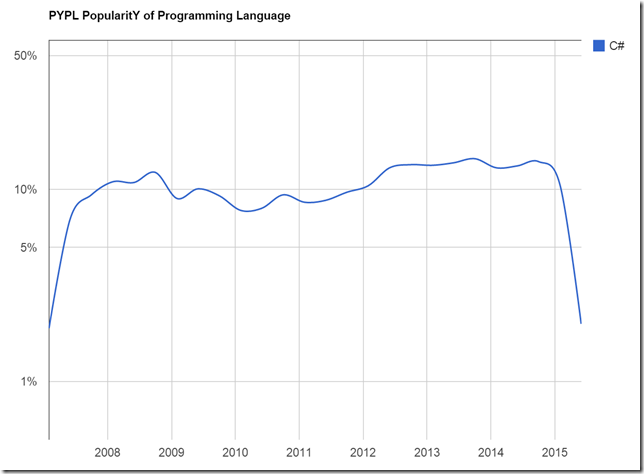Microsoft’s C# programming language first appeared in 2000, over 15 years ago, that’s a long time in tech.
Every month or so there’s a “Leaving .Net” articles, the last one I bumped into was “The collapse of the .net ecosystem” from Justin Angel:
The article shows, through a series of charts, the level of interest in C# peaking and then falling.
This is what I’d consider to be the natural continuum of things, where languages have their day, and then slowly decline. In the past C was my primary language, then C++ and so on, why should C# be any different?
Disclaimer: This is not a leaving .Net post, just some of my own research that I thought I’d share, with a focus on the UK as that’s where I live.
Job trends
Indeed.com provides statistics on job placements with specific keywords, lets look at C#:

This chart appears to show job adverts peaking between around 2010 and 2012 and tapering off fairly heavily after that.
Google trends
Google trends lets you track interest over time based on a keyword, here I'm looking at C# in the UK:
On this chart the peak seems to be earlier, around 2009, perhaps the trend can be seen earlier in the UK, but again the decline in interest is clearly visible.
TIOBE
Questions around the validity of TIOBE’s numbers abound, but here it is anyway:

Here the peak appears to be around 2012, although the drop is perhaps less pronounced.
PYPL
Yet another popularity index this time tracking google trends for “C# tutorial” in the UK:

This chart shows uses a logarithmic scale, however what we might surmise, if the numbers are to believed, is that interest in C# appears to fall off a cliff towards the end of 2014.
Stack Overflow
The recent stackoverflow developer survey also shows a significant decline in interest from 44.7% in 2013 to 31.6% in 2015. Developer’s current preferences are also quite revealing:

Where’s everyone gone?
This is only conjecture, but from my experience of .Net oriented developer events over the years in the UK, C# has always had a significant focus on the web and ASP.Net. My suspicion is that with the rise of thick-client JavaScript and mobile, significant numbers of developers have been migrating naturally towards those ecosystems.
Should I panic?
Probably not, there’s still plenty of C# jobs out there for now, and hell, some of the best paid jobs nowadays are for maintaining C++ and even COBOL systems. But if the numbers are anything to go by then we can say that C# interest has peaked.
That said who knows what the future will hold and perhaps like C++ there’ll be a renaissance in the future, although C++’s renaissance never really brought it back to the levels of it’s heady hey days.
Then again perhaps it’s more pragmatic not to dwell too heavily on the past, accept the numbers, and look to a new future. If you’re skills extend beyond one language then I guess you’ve probably got nothing to worry about, otherwise perhaps it’s time to pick up a new language and new paradigms.
And I’ll leave you with a question: Do you think you’ll be using the same programming language in 5 years time?